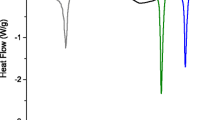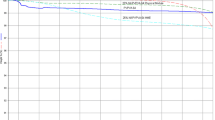Abstract
The purpose of this study was to improve dissolution behavior of poorly water-soluble drugs by application of cyclodextrin in extrusion processes, which were melt extrusion process and wet extrusion process. Indomethacin (IM) was employed as a model drug. Extrudates containing IM and 2-hydroxypropyl-β-cyclodextrin (HP-β-CyD) in 1:1 w/w ratio were manufactured by both melt extrusion process and wet extrusion process. In vitro drug release properties of IM from extrudates and physiochemical properties of extrudates were investigated. The dissolution rates of IM from extrudates manufactured by melt extrusion and wet extrusion with HP-β-CyD were significantly higher than that of the physical mixture of IM and HP-β-CyD. In extrudate manufactured by melt extrusion, γ-form of IM changed to amorphous completely during melt extrusion due to heating above melting point of IM. On the other hand, in extrudate manufactured by wet extrusion, γ-form of IM changed to amorphous partially due to interaction between IM and HP-β-CyD and mechanical agitating force during process. Application of HP-β-CyD in extrusion process is useful for the enhancement of dissolution rate for poorly water-soluble drugs.









Similar content being viewed by others
References
Thanos CG, Liu Z, Goddard M, Reineke J, Bailey N, Cross M, et al. Enhancing the oral bioavailability of the poorly soluble drug dicumarol with a bioadhesive polymer. J Pharm Sci. 2003;92:1677–89.
Serajuddin ATM. Solid dispersion of poorly water-soluble drugs: early promises, subsequent problems, and recent breakthroughs. J Pharm Sci. 1999;88:1058–66.
Leuner C, Dressman J. Improving drug solubility for oral delivery using solid dispersions. Eur J Pharm Biopharm. 2000;50:47–60.
Szejtli J. Cyclodextrin technology. Dordrecht: Kluwer; 1988.
Duchêne D. New trends in cyclodextrins and derivatives. Paris: Editions de Santé; 1991.
Uekama K. Design and evaluation of cyclodextrin-based drug formulation. Chem Pharm Bull. 2004;52(8):900–15.
Uekama K, Hirayama F, Irie T. Cyclodextrin drug carrier systems. Chem Rev. 1998;98:2045–76.
Uekama K, Hirayama F, Arima H. Recent aspect of cyclodextrin-based drug delivery system. J Incl Phenom Macrocycl Chem. 2006;56:3–8.
Davis ME, Brewster ME. Cyclodextrin-based pharmaceutics: past present and future. Nat Rev. 2004;3:1023–35.
Pitha J, Milecki J, Fales H, Pannell L, Uekama K. Hydroxypropyl- β-cyclodextrin: preparation and characterization; effects on solubility of drugs. Int J Pharm. 1986;29:73–82.
Yoshida A, Yamamoto M, Itoh T, Irie T, Hirayama F, Uekama K. Utility of 2-hydroxypropyl-beta-cyclodextrin in an intramuscular injectable preparation of nimodipine. Chem Pharm Bull. 1990;38(1):176–9.
Loftsson T, Ólafsdóttir BJ. The effect of 2-hydroxypropyl-β-cyclodextrin on the simultaneous dissolution and degradation of chlorambucil. Int J Pharm. 1990;66:289–92.
Hirayama F, Wang Z, Uekama K. Effect of 2-hydroxypropyl-β-cyclodextrin on crystallization and polymorphic transition of nifedipine in solid state. Pharm Res. 1994;11:1766–70.
Hirayama F, Usami M, Kimura K, Uekama K. Crystallization and polymorphic transition behavior of chloramphenicol palmitate in 2-hydroxypropyl-β-cyclodextrin matrix. Eur J Pharm Sci. 1997;5:23–30.
Kimura K, Hirayama F, Arima H, Uekama K. Solid-state 13C nuclear magnetic resonance spectroscopic study on amorphous solid complexes of tolbutamide with 2-hydroxypropyl-α- and -β-cyclodextrins. Pharm Res. 1999;16:1729–34.
Hicks DC, Freese HL. Extrusion and spheronizing equipment. In: Ghebre-Sellassie I, editor. Pharmaceutical pelletization technology. New York: Marcel Dekker; 1989. p. 71–100.
Faubion JM, Hoseney RC, Seib PA. Functionality of grain components in extrusion. Cereal Foods World. 1982;27:212–6.
Sokhey AS, Kollengode AN, Hanna MA. Screw configuration effects on corn starch expansion during extrusion. J Food Sci. 1994;59:895–8.
Lefebvre C, Brazier M, Robert H, Guyot-Hermann AM. Solid dispersions why and how? Industrial aspect. STP Pharma. 1985;4:300–22.
Gamlen MJ, Eardley C. Continuous extrusion using a Baker Perkins MP50 (multipurpose) extruder. Drug Dev Ind Pharm. 1986;12:1701–13.
Kleinebudde P, Lindner H. Experiments with an instrumented twin-screw extruder using a single-step granulation/extrusion process. Int J Pharm. 1993;94:49–58.
Schroeder R, Steffens KJ. A new system for continuous wet granulation. Pharm Ind. 2002;64:283–8.
Lindberg NO, Tufvesson C, Olbjer L. Extrusion of an effervescent granulation with twin screw extruder, Baker Perkins MPF 50 D. Drug Dev Ind Pharm. 1987;13:1891–913.
Lindberg NO. Some experiences of continuous wet granulation. Acta Pharm Suec. 1988;25:239–46.
Lindberg NO, Tufvesson C, Holm P, Olbjer L. Extrusion of an effervescent granulation with twin screw extruder, Baker Perkins MPF 50 D. Influence on intragranular porosity and liquid saturation. Drug Dev Ind Pharm. 1988;14:1791–8.
Rambali B, Verreck G, Baert L, Massart DL. Itraconazole formulation studies of the melt-extrusion process with mixture design. Drug Dev Ind Pharm. 2003;29:641–52.
Fukuda M, Miller DA, Peppas NA, McGinity JW. Influence of sulfobutyl ether β-cyclodextrin (Captisol®) on the dissolution properties of a poorly soluble drug from extrudates prepared by hot-melt extrusion. Int J Pharm. 2008;350:188–96.
Otsuka M, Kato F, Matsuda Y. Comparative evaluation of the degree of indomethacin crystallinity by chemoinfometrical fourie-transformed near-infrared spectroscopy and conventional powder X-ray diffractiometry phase solubility techniques. AAPS PharmSci. 2000;2(1):9.
Higuchi T, Connors KA. Phase solubility techniques. Adv Anal Chem Instrum. 1965;4:117–22.
Hoshino T, Tagawa Y, Hirayama F, Otagiri M, Uekama K. Inclusion complexation of indomethacin and its related compounds with cyclodextrin in aqueous solution. Yakugaku Zasshi. 1982;102:1184–90.
Backensfeld T, Müller BW, Kolter K. Interaction of NSA with cyclodextrins and hydroxypropyl cyclodextrin derivatives. Int J Pharm. 1991;74:85–93.
ACKNOWLEDGEMENT
The authors are grateful to Ms. Karin Matthée of Institute of Pharmaceutics and Biopharmaceutics, Heinrich-Heine-University for helpful measurement of DSC. Hideki Yano expresses his appreciation to Daiichi Sankyo Co., LTD. for granting him a 1-year leave of absence to pursue these studies.
Author information
Authors and Affiliations
Corresponding author
Additional information
Guest Editors: Michael Repka, Joseph Reo, Linda Felton, and Stephen Howard
Rights and permissions
About this article
Cite this article
Yano, H., Kleinebudde, P. Improvement of Dissolution Behavior for Poorly Water-Soluble Drug by Application of Cyclodextrin in Extrusion Process: Comparison between Melt Extrusion and Wet Extrusion. AAPS PharmSciTech 11, 885–893 (2010). https://doi.org/10.1208/s12249-010-9448-2
Received:
Accepted:
Published:
Issue Date:
DOI: https://doi.org/10.1208/s12249-010-9448-2




